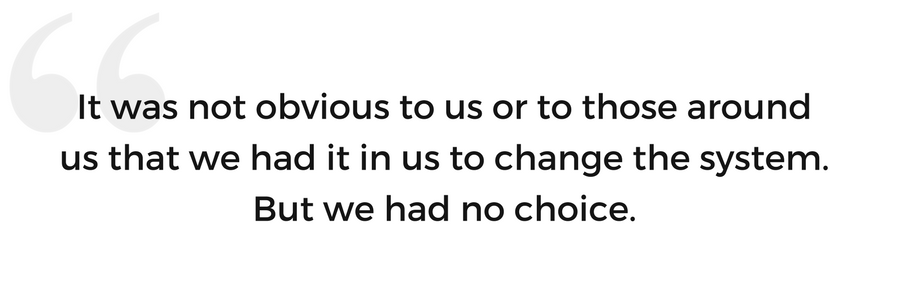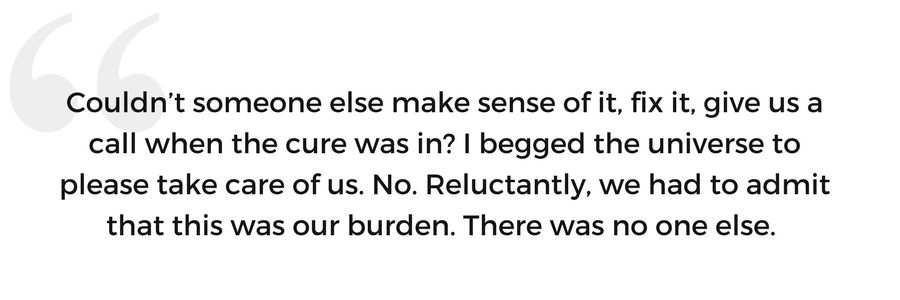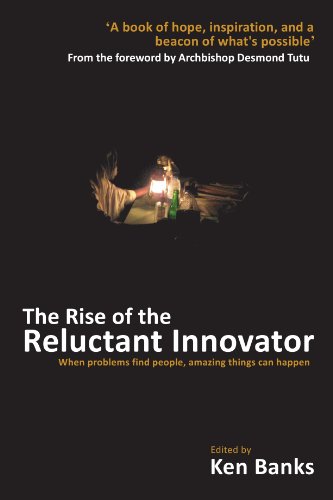Each year, hundreds – if not thousands – of engaged students walk through the doors of schools, colleges and universities around the world eager to learn the art of social change. Classes in social innovation, social entrepreneurship and design thinking, among many others, have become increasingly popular. On the one hand, this might all be seen as a good thing – after all, the world needs as many smart, engaged citizens as it can get, particularly when you consider the multitude of challenges we face as a planet.
But does a career in social change really begin in the classroom, or out in the real world? How much social change is planned, and how much accidental? And which approach tends to lead to the most meaningful, lasting or impactful solutions? These are questions I tackle in my book, The Rise of the Reluctant Innovator.
How much social change is planned, and how much accidental? Tweet This Quote
Whilst classes in social innovation, social entrepreneurship or design thinking promise to teach you all you need to know about the mechanics of the discipline, one thing is often missing – a target for all that passion and energy. More often than not, you only find this once you’ve got yourself out into the world and come across a problem which troubles, disturbs or is challenging enough for you to dedicate your life to putting it right. Finding that one thing is by far the most important piece of the puzzle, and it’s the part people struggle with the most. As Howard Thurman reminds us, “Don’t ask yourself what the world needs. Ask yourself what makes you come alive and then go do that. Because what the world needs is people who come alive.”
The Rise of the Reluctant Innovator is something of a challenge to conventional wisdom. The ten innovators featured in the book didn’t set out to solve anything; in most cases, they certainly weren’t qualified to when they stumbled across their particular problem. For most, taking it on has been life changing, and their passion, dedication and frustrations are laid bare. The concept of reluctance comes from the knowledge that their lives wouldn’t be the same again, and that the easier option would be to turn their backs. But they didn’t, because they simply couldn’t.
Here’s Sharon Terry’s story of reluctance.
Without mud there is no lotus
There are those moments in life you know you will remember forever. They constitute a clear and delineated threshold. You cross it and there is no going back. It is very different than remembering where you were when you heard that John Kennedy was shot, or the Berlin Wall was no longer a barrier. Life is a different colour and hue on the other side.
This sort of moment propelled me into a reluctant, deeper, entrepreneurism. I say deeper, because it led to the discovery that I have been a reluctant entrepreneur all of my life. Adversities of one kind or another have called my creativity forth and refined it in a crucible, a process that I often fought against. For me, the essence of who I am has been called into fullness by adversity. Entrepreneurism is simply a mechanism, and sometimes the expression of a neurosis, by which I have become me.
The build-up to that moment was a particular kind of rollercoaster ride, sometimes called the diagnostic odyssey. I was at my niece’s first birthday party in 1992, the first happy event since the death of my brother about four months before, and I noticed in the softening sunlight three small dots on each side of my daughter’s neck. It was a hot September afternoon in Connecticut, and I thought about this discovery for a moment, feeling a little flip of fear in my stomach, and then let it go – returning to the quest for equilibrium for our extended family in the face of the large hole left by Stephen’s death at thirty-one years old.
Over the following months, and years, I asked our paediatrician periodically: ‘What are these dots? Why are they only on the sides of her neck? Why are they slowly increasing in number over time? Are they important? Should I ignore them?’ She repeatedly reassured me that I was needlessly worried. She suggested it was a laundry detergent allergy. I wasn’t convinced and silently baulked – why weren’t these dots all the way around her neck? Then, reassuring myself, I would agree with her that I was neurotically suspicious of the slightest thing since my brother’s death, and yes, I should be in therapy mitigating that neurosis. Or probably these dots weren’t really progressing, right? Then why did photos from year to year look so different? Thank goodness I was in therapy as this chapter unfolded!
I do not know what finally led us to it, but my husband Pat and I decided to go ‘out-of-pocket’ and ‘out-of-plan’ to a dermatologist – meaning we would pay for the visit to a physician that wasn’t approved by our particular insurance plan. I set up an appointment, told Pat he needn’t come since I would undoubtedly hear that it was an allergy of some sort, and off we went, Elizabeth and her younger brother Ian, to see the doctor on December 23rd, 1994 – that defining moment looming up ahead as we marched into it, oblivious.
 It all happened in what seemed like a split second. Dr Lionel Bercovitch glanced at Elizabeth’s neck, said ‘She has pseudoxanthoma elasticum.’ As my stomach began to churn at the sound of the syllable ‘oma’ (weren’t there cancers like melanoma, and lymphoma?) he glanced at Ian and added, ‘Oh, and he has it, too.’ Then he shut off the lights and looked in her eyes with an ophthalmoscope. ‘What? Just stop right here!’ I wanted to scream. This was a skin problem – what was he doing looking in her eyes? Yes, her eyes were affected too. I had crossed the threshold. I did not know where I was, I was frightened and it was dark.
It all happened in what seemed like a split second. Dr Lionel Bercovitch glanced at Elizabeth’s neck, said ‘She has pseudoxanthoma elasticum.’ As my stomach began to churn at the sound of the syllable ‘oma’ (weren’t there cancers like melanoma, and lymphoma?) he glanced at Ian and added, ‘Oh, and he has it, too.’ Then he shut off the lights and looked in her eyes with an ophthalmoscope. ‘What? Just stop right here!’ I wanted to scream. This was a skin problem – what was he doing looking in her eyes? Yes, her eyes were affected too. I had crossed the threshold. I did not know where I was, I was frightened and it was dark.
Dr Bercovitch turned the lights back on, explained to me that he was trained in dermatology and ophthalmology and so could see both the skin and eye effects of pseudoxanthoma elasticum (PXE). I could not absorb the words he was speaking. Something about this being systemic, and an autosomal recessive disease, and not much being known about it. I just saw my gorgeous children, and heard him speak about wrinkly sagging skin and blindness.
I went home, called Pat and sobbed about the disfigurement that our children would be facing in their future. Oh, how foolish to worry about their skin and appearance, when blindness was a strong possibility! I then called our pediatrician. She pulled a book from her shelves and read to me. This was a disease that would cause skin, eye, cardiac and vascular problems. Pat came home and we tried to have a normal dinner so the kids wouldn’t worry, too.
Dr Bercovitch called us after dinner. We thought this extraordinary, but were even more astounded to learn that he lived just a few houses away. He offered to speak with us the next evening, Christmas Eve, at his house, while another neighbour came and watched Elizabeth and Ian.
That night, we struggled to understand what he was telling us and realised we knew too little to digest it. We would need some basic references and then some time to get up to speed. Elizabeth and Ian remember that Christmas, when they were seven and five years old respectively, as the best Christmas of their lives. They got every toy they wished for and more. They were joyful and happy little kids, unaware that anything had changed. As they learned about the condition, they learned the long Latin name. They began to name spiders and plants ‘Pseudoxanthoma elasticum’ – believing it sounded sufficiently scientific.
Discovering the problem is beyond us
The weeks following Christmas were difficult ones. I went to two medical school libraries and photocopied every article on PXE that I could find, pawing through the card catalogue in those pre-Internet days. I brought home 400 articles, and couldn’t understand any of them – only that there were grotesque photos of sagging skin, and descriptions of early blindness and premature death. Pat and I eagerly and anxiously combed through the articles, and though we were clueless as to the details, we began to see patterns.
The first pattern: there was no pattern. These authors were writing from a hundred different perspectives, only reporting one case, and then drawing conclusions about the disease from the single case. We did not understand how one could characterise a disease with only one case, something we later learned is called an ‘N of 1’. The next pattern that was apparent to us was that seemingly unrelated things were associated and supposed to tell a story. As an example, there was a paper on a 13-year-old who died ‘from PXE’. However, she also had a seizure disorder and had attempted suicide several times. We couldn’t tell whether PXE was the cause of her death. How could the author be certain? Who were we to question the author of a scientific paper, published in a journal?
PXE appeared to be characterised differently in different geographic locations, and while it is certainly true that geographic isolation or ancestral origin could produce variations in the disease, there seemed to be extreme differences between similar populations. It was also troubling that all of the reports were positive – there were no failed experiments reported. How would researchers learn if the failed experiments were not made public? Another pattern that emerged was a lack of collaboration. In the few cases where an author wrote multiple papers, it seemed that those papers were with the same group of authors. There was no cross-over, or cross-fertilisation.
 The issue of collaboration, or actually competition, became poignantly clear for us in the days following the diagnosis of our children. A few days after Christmas, a scientist from Harvard called to ask whether he could have a sample of our children’s blood for a study seeking to find the gene associated with PXE. We readily agreed to the visit from the researcher’s assistant and the kids’ blood was drawn. Two days later a researcher from Mt Sinai Hospital called and asked the same. We told him: ‘Sure, the researcher from Harvard took several vials and certainly he would share. No one would ask little children to have blood drawn twice!’ He chuckled: ‘No, they won’t share with us, we are racing each other to find the gene.’ This was astounding to us. While of course we had seen competition in many areas of life, it was unthinkable that there was competition in biomedical research. Wasn’t everyone focused on solving these issues as soon as possible, with the highest degree of collaboration since the stakes were huge? No, that is not what was happening. We were shocked.
The issue of collaboration, or actually competition, became poignantly clear for us in the days following the diagnosis of our children. A few days after Christmas, a scientist from Harvard called to ask whether he could have a sample of our children’s blood for a study seeking to find the gene associated with PXE. We readily agreed to the visit from the researcher’s assistant and the kids’ blood was drawn. Two days later a researcher from Mt Sinai Hospital called and asked the same. We told him: ‘Sure, the researcher from Harvard took several vials and certainly he would share. No one would ask little children to have blood drawn twice!’ He chuckled: ‘No, they won’t share with us, we are racing each other to find the gene.’ This was astounding to us. While of course we had seen competition in many areas of life, it was unthinkable that there was competition in biomedical research. Wasn’t everyone focused on solving these issues as soon as possible, with the highest degree of collaboration since the stakes were huge? No, that is not what was happening. We were shocked.
Another pattern that emerged is that nothing was being done systematically about this disease. There was no learning from one paper to another, experiments were repeated, and no one was mapping the scientific patterns that might be found in the data. And finally, a strange and horrible pattern became evident. People were called subjects in these papers. They were not collaborators, and certainly not empowered to participate.
Within a month of Elizabeth’s and Ian’s diagnoses, we had to let go of the misconception that every disease had some treatment. We needed to step away from the illusion that this was the medical equivalent of a delicatessen counter. No one was going to call our number, so there was no use waiting hopefully until someone got to the ‘P’s. We also had to figure out a way to make order out of the chaos that appeared in the papers we read, and in the competition we experienced in the blood collections for research.
Science: Is it so different from all of the other challenges?
Trained as a teacher and a college chaplain, I was ill-prepared for the piles of medical journal papers. I was as clueless about research as my engineering husband, who is fond of saying ‘we didn’t know a gene from a hubcap’. It was not obvious to us or to those around us that we had it in us to change the system. But we had no choice.
As we fell asleep each night amid piles of photocopied papers and enormous medical dictionaries, we knew we had to take the bull by the horns. I remember an evening when we looked at each other, and thought, no, no, no – we don’t want to do this – we do not want to create a system for this disease. Wasn’t it enough to live with it, to cope with it, to walk our kids through it? Couldn’t someone else make sense of it, fix it, give us a call when the cure was in? I begged the universe to please take care of us. No. Reluctantly, we had to admit that this was our burden. There was no one else.
That decision made, we rolled up our sleeves and plunged in.





